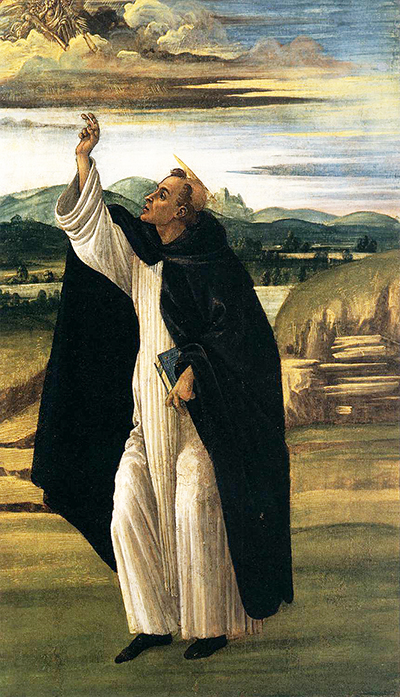St Dominic is a small artwork from the late 1490s which now resides in the Hermitage Museum in Saint Petersburg, Russia. Some have dated this piece more loosely as 1498-1505.
Many question marks remain regarding this artwork, though we do know that this piece was originally produced as tempera on panel before being transferred onto canvas in order to be moved elsewhere. It is sized at just 45cm in height, and 26cm in width. Within this painting we find St Dominic with his hand in the air, giving out a gesture of blessing. He is dressed in traditional religious clothing and holds a book in his left hand. Most depictions of saints will have symbolic touches such as this. Behind this figure we find a sprawling landscape, with hills in the far distance beneath a bright sky line with an assortment of clouds filling the horizontal space. There is a careful gradient of colour from foreground to background as we move through tones of green and transition to blue at the very back. Most would not notice this and focus entirely on the Saint who poses prominently in the foreground.
St Dominic was the founder of the Dominican order of monks and is someone who artists have chosen to capture fairly frequently, most commonly within the Renaissance. The saint would famously walk by himself through the Italian landscape, accompanied only by a book of scripture and that is what inspired the painting in front of us here. The Hermitage, where this item remains, is very much the finest gallery to be found in Russia, and can be considered amongst the best in the whole world, thanks to donations from a number of prominent collectors over the past few centuries. The state would also acquire many of the most famous artworks from around Europe and together the collection would grow considerably over an extended period.
Those interested in following religious themes and figures within Italian art may also like the work of Giotto di Bondone, an artist who helped to bridge the gap between the medieval styles and the later Renaissance. Some of his highlights included panel paintings like Lamentation (The Mourning of Christ), Ognissanti Madonna and Adoration of the Magi, with a good selection of his work still around today, even though he worked so many centuries ago. For many years religion would dominate the content of art across Italy before artists started to try out other ideas and eventually a greater variety was encouraged and appreciated by patrons across this fragmented part of Europe. Many themes within Christianity have been covered in different ways by artists who have each attempted to re-invent them with their own creative ideas.




